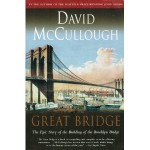David McCullough
Books: History | Biography
The Great Bridge: The Epic Story of the Building of the Brooklyn Bridge (1972), Brave Companions: Portraits In History (1992)
The Great Bridge: The Epic Story of the Building of the Brooklyn Bridge (1972)
 I picked up this book while perusing the "Buy 3 get a 4th Free" table at a book store, and it looked interesting, and I like to read about history, so I figured, why not?
I picked up this book while perusing the "Buy 3 get a 4th Free" table at a book store, and it looked interesting, and I like to read about history, so I figured, why not?
When the perfected East River bridge shall be permanently and uninterruptedly connect the two cities, the daily thousands who cross it will consider it a sort of natural and inevitable phenomenon, such as the rising and setting of the sun, and they will unconsciously overlook the preliminary difficulties surmounted before the structure spanned the stream, and will perhaps undervalue the indomitable courage, the absolute faith, the consummate genius which assured the engineer’s triumph.
–Thomas Kinsella
Of course, I tend to read non-fiction before bed, which means that it takes me a really long time to finish them, and at more than 550 pages, reading a couple pages every night before falling asleep means I don’t have a lot of forward momentum. Except, of course, when things get fascinating, in which case I get more reading than sleeping done.
Despite going over bridges all the time, I never actually thought about the process of making them. I never realized just how fascinating architecture was.
The most technical difficult part of the bridge was sinking the towers until they reached bedrock. It was in this section that I learned that "The Bends" were first called "Cassion disease" because it was in the sinking of cassions when building bridge towers that it was first discovered. It was also cassion disease that ruined the health of Washington Roebling, chief engineer of the bridge.
Of course, the story is as much about John Roebling and his wife Emily Warren as it was about the architecture and engineering. And as impressive as Washington Roebling was, I think Emily was even more impressive. She not only ran a household with a husband who was almost completely incapacitated, she also was Washington’s conduit with the outside world, discussing technical issues with his engineers on a regular basis.
And don’t forget we also get a small slice of the history of Brooklyn (and also of the downfall of Tammany Hall) as they were an integral part of the building of the bridge.
There was more to be said for Brooklyn. Gas rates were reasonable. Taxes were still lower than in New York. The schools were far superior. Local government was reputed to be honest, which it was not, but in contrast tot he way things were done on the other side of the river it looked pretty god. Streets were reasonably well lighted after dark and for a city of its size there was little crime. The drinking water was delicious.
As I said, the book is over 600 pages with indexes and appendices, and covers everything from the politics in Brooklyn & New York to the engineer feats in the building of the towers to Washington and Emily Roebling and how they coordinated the entire thing.
My one major complaint was already covered on my main blog, and that was an error that completely boggled me for several moments, where immigrate was used instead of the proper emigrate. I find it hard to believe that a book that has been in publication for almost 40 years could have that glaring of an error, but there it was. I really would like to know if that error existed in earlier versions of the book or was added in after the reprint.
But overall, my verdict: Fascinating.
Rating: 8/10
Published by Simon & Schuster Paperbacks
Brave Companions: Portraits In History (1992)
 This collection of essays move forward in American history, as David McCullough writes about everyone from Harriet Beecher Stowe to Emily Roebling to the city of Washington D.C.
This collection of essays move forward in American history, as David McCullough writes about everyone from Harriet Beecher Stowe to Emily Roebling to the city of Washington D.C.
Perhaps oddly, it is the last essay (the one that reads like a graduation speech) that I liked the best. For in it, he writes first of the tremendous changes that have occurred since 1936:
Real progress has been made, in much of everyday life. Anyone who doubts this need only imagine–or recall–a visit to a 1930's dentist.
This is one of the things I try to remember when technology and the modern world become frustrating: It is so much better to be living in the future.
But more important he writes of the importance of history:
Imagine a man who professes over and over his unending love for a woman but who knows nothing of where she was born or who her parents were or where she went to school or what her life had been until he came along–and furthermore, doesn’t care to learn. What would you think of such a person? Yet we appear to have an unending supply of patriots who know nothing of the history of this country, nor are they interested.
That. That right there is why I read about history.
Published by Simon & Schuster
Rating: 8/10
